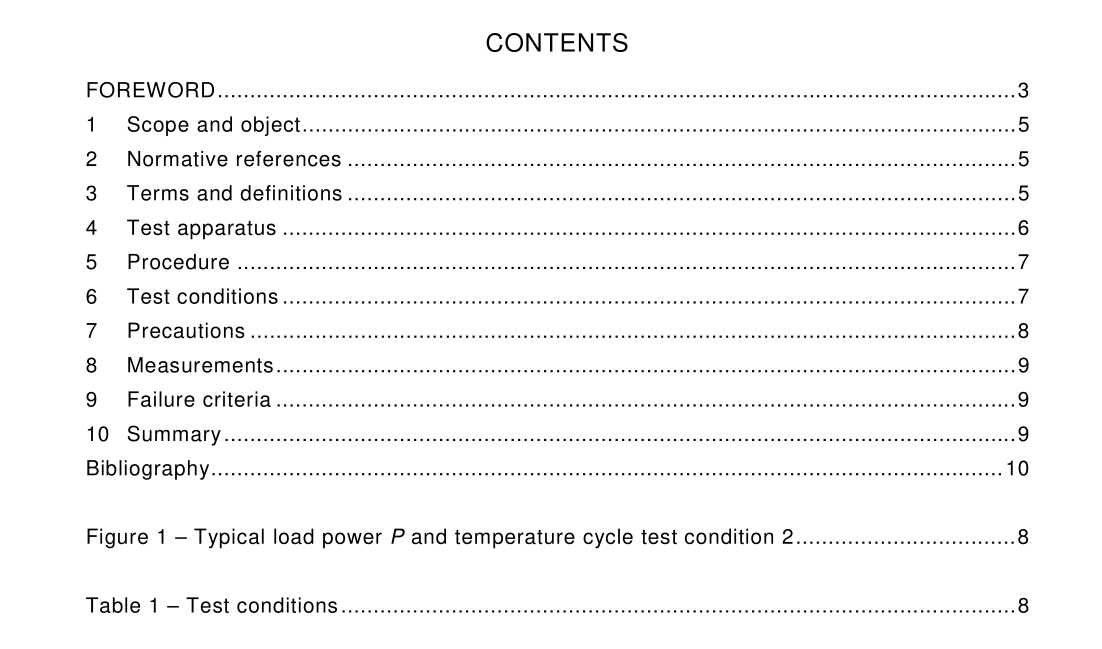IEC 60749-34 pdf download.Semiconductor devices – Mechanical and climatic test methods – Part 34: Power cycling
1 Scope and object
This part of IEC 60749 describes a test method used to determine the resistance of a semiconductor device to thermal and mechanical stresses due to cycling the power dissipation of the internal semiconductor die and internal connectors. This happens when low- voltage operating biases for forward conduction (load currents) are periodically applied and removed, causing rapid changes of temperature. The power cycling test is intended to simulate typical applications in power electronics and is complementary to high temperature operating life (see IEC 60749-23 ). Exposure to this test may not induce the same failure mechanisms as exposure to air-to-air temperature cycling, or to rapid change of temperature using the two-fluid-baths method. This test causes wear-out and is considered destructive. NOTE It is not the intention of this specification to provide prediction models for lifetime evaluation.
3 Terms and definitions
For the purposes of this document the following terms and definitions apply. NOTE Further terms and definitions concerning semi-conductor devices are contained in the IEC 60747 and IEC 60748 series. 3.1 3.2 load current current to which the devices are subjected to produce power loss P case temperature T c temperature of the base of the device under test facing the heat sink
4 Test apparatus
The apparatus required for this test shall consist of heat sinking for a group of devices or alternatively for each individual device under test with the purpose of dissipating the forward conduction losses and of controlling on- and off-times. The heat sinking can be selected from natural or forced air convection or liquid cooling. Pre-selected temperature excursions of the device ground plates and of the die junctions, as well as on- and off-times determine heat sinking set-up and parameters. Sockets or other mounting means shall be provided so that reliable electrical contact can be made without excessive heat transfer to the device terminals. Power supplies shall be capable of maintaining the specified operating conditions throughout the testing period despite normal variations in line voltage or ambient temperatures. On- and off-switching of load currents should be provided by the test circuit independent of any (gate-) control functions of the devices under test. On- and off-times (cycle period) shall be controlled by monitoring either heat sink T s or case temperature T c . Alternatively, the cycle period can also be controlled by fixed time settings, if appropriate. The test circuit should also be designed so that the existence of abnormal or failed devices does not alter the specified conditions for other units on test (e.g. the latter might be accomplished by exchanging defective units with new ones). Care should be taken to avoid possible damage from transient voltage spikes or other conditions that might result in electrical, thermal or mechanical overstress.
5 Procedure
When special mounting or heat sinking is required, the details shall be specified in the applicable procurement documents. Load current and waveforms shall be selected close to the preferred application of the devices under test, as outlined below. Rectifier devices such as diodes or SCRs that are normally used as a.c. lines converters should be connected to 50 Hz or 60 Hz a.c. power supplies; bridge rectifiers should be operated as such, i.e. a.c. line voltages applied to the a.c. input terminals and output terminals shorted via shunt resistors to monitor load current. MOS-controlled devices such as power MOSFETs or IGBTs should be connected to d.c. power supplies. Modules with multiple functions can be operated stepwise and separate according to their internal circuits. Gate-controllable devices such as SCRs, IGBTs and MOSFETs should be set into a continuous forward conductive state by appropriate gate controls throughout the entire test duration. The power should be applied and suitable checks made to assure that all devices are properly biased. During the test, the power applied to the devices shall be alternately cycled as given in Table 1 , unless otherwise specified in the relevant specification. The devices shall concurrently be cycled between temperature extremes for the specified number of cycles. The power cycling test shall be continuous except when parts are removed from the test fixtures for interim electrical measurements. If the test is interrupted as a result of device, power or equipment failure, the test shall restart from the point of stoppage.
IEC 60749-34 pdf download
